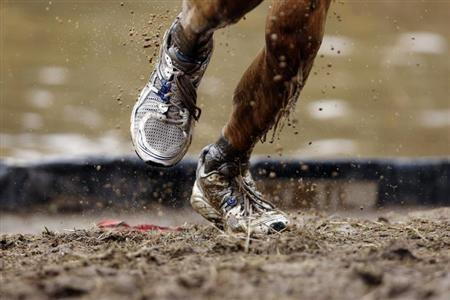It’s All about the Roll in Footing When Choosing Running Shoes
posted: Aug. 06, 2013.
 Fitness experts have always warned clients to choose a running shoe based on their roll or pronation, not by the way they look. According to Dorene Internicola of Reuters, analyzing the rolling of a foot has always been the standard practice among fitness and medical professionals, believing it will lead to better shoe fit and fewer injuries.
Fitness experts have always warned clients to choose a running shoe based on their roll or pronation, not by the way they look. According to Dorene Internicola of Reuters, analyzing the rolling of a foot has always been the standard practice among fitness and medical professionals, believing it will lead to better shoe fit and fewer injuries.
At Jack Rabbit Sports store in New York City, clients’ arches are observed before they hit the treadmill and monitored for pronating. "The basic premise is that most people land on their heel (and) overpronate or underpronate," said Johanna Bjorken, the store's merchandise director. "These causes running injuries and shoes can address this. This has been the model."
When beginning a new exercise regimen, such as running, it is recommended to seek the care of a chiropodist like Marz Hardy of Academy Foot and Orthotic Clinics. Hardy will not only provide you with recommendations for the appropriate footwear to use while running, but can also treat and care for all your foot injuries.
Choosing the Right Running Shoes for Your Foot Type
Running is a physical activity although fun, can put a lot of stress on the joints, bones and ligaments of the body. Injury and stress on the foot can be an important factor on which kind of shoe you’re wearing. Running shoes should be worn based on your foot type. It is important to find out what fits you based on cushioning, stability and motion.
Determining your type
Speak with a shoe specialist or retail professional to see what your foot type is. They will be able to identify and measure your arch type, stride and gait.
Running Mechanics
When you are running or walking in your shoes, every step determines how your foot is landing. Pronation is the natural rolling of your ankle from outside to inside during foot strike.
Pronation is a correct form of walking or running. It helps absorb shock and store energy from your lower extremities. Neutral runners who pronate correctly do not need specific shoes, since they have stability and control.
Over-pronators
those people who run with excessive ankle rolling. Over-pronators tend to have ankles that angle inward, flat feet, and or bowed legs. This can cause a series of injuries: of the knees, ankles and Achilles tendons. Finding a shoe with extra stability and control is vital to well-balanced walking and overall foot health.
Under-pronation
is less common than over-pronation. This usually happens to those who have inflexible feet and high arches. When the feet land, they are unable to roll inward. Even though there is less rotational stress on the ankles and knees, it prevents any kind of shock absorptions. This can often lead to fractures, ligament tears and muscle strains. Under-pronations need shoes with increase in cushion and flexibility.
If you are unsure which shoes accommodate your feet, always speak to your foot specialist, or professional.
If you have any questions, please contact our office in Toronto, ON. We offer the newest diagnostic and treatment technologies for all your foot care needs.
Read more on Choosing the Right Running Shoes for Your Foot Type.